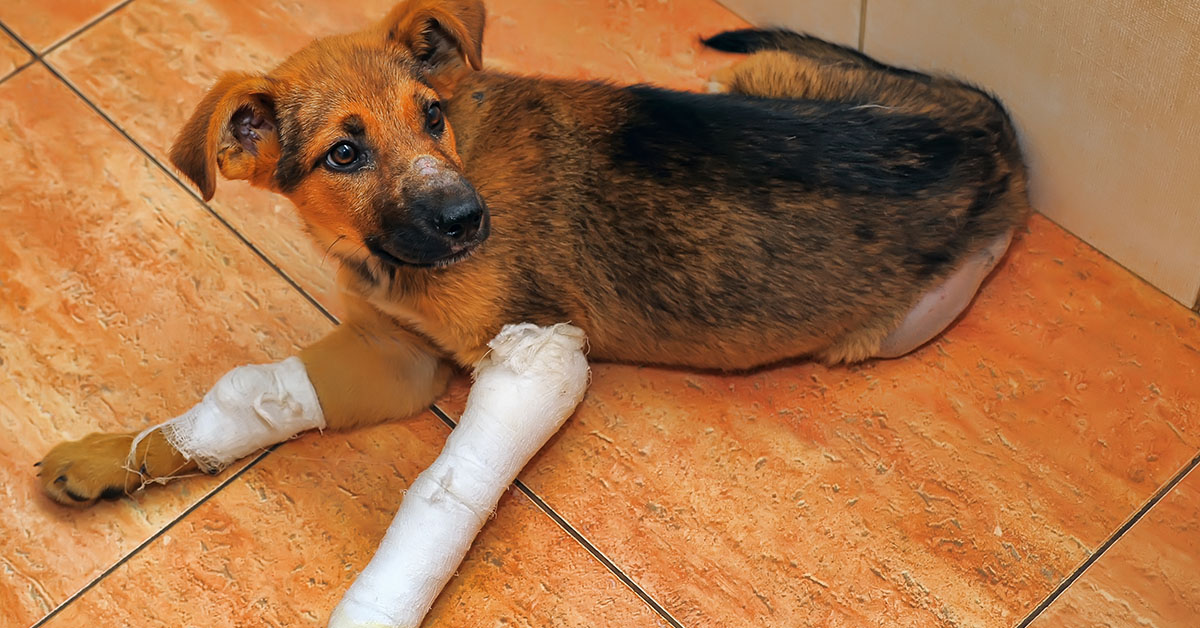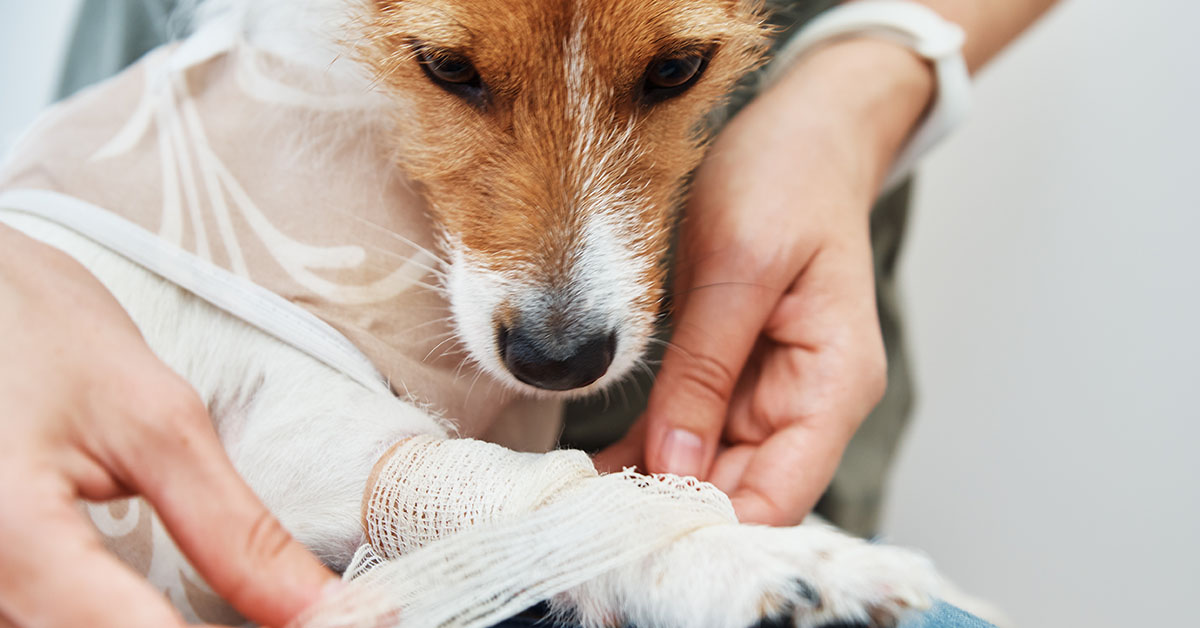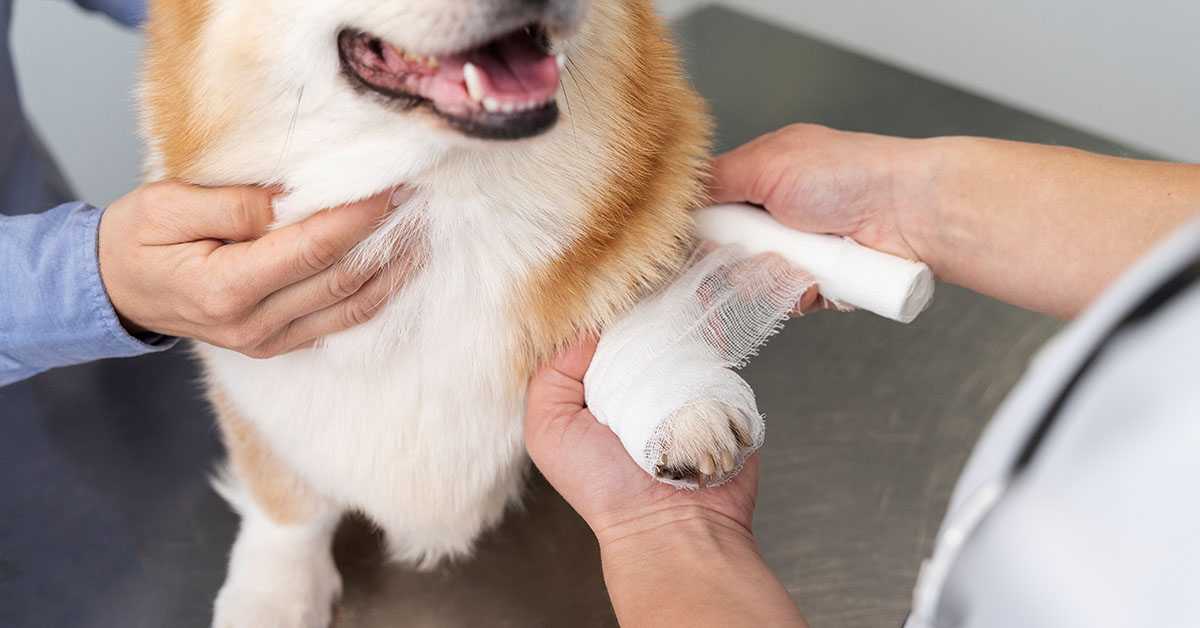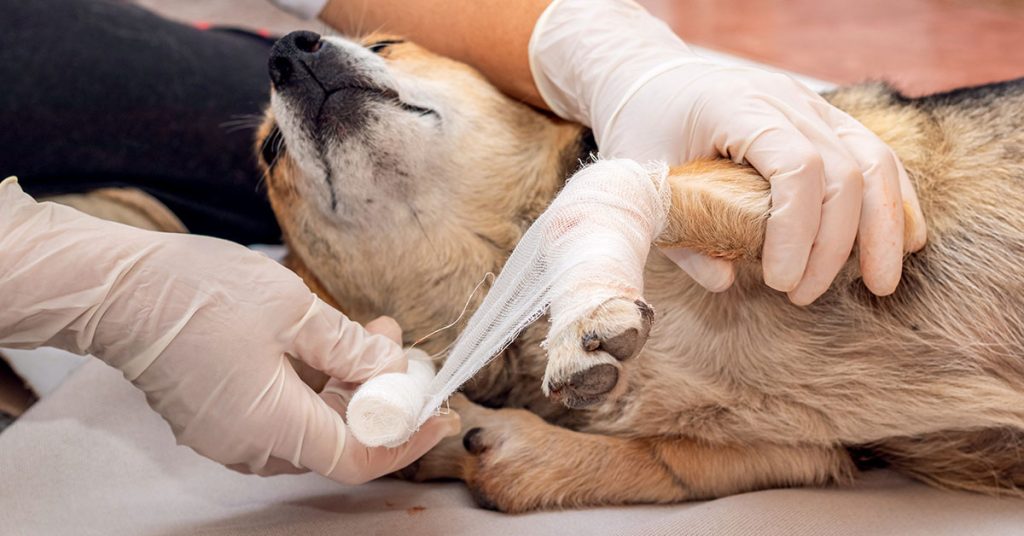As our pet dogs lead active lifestyles, they often suffer injuries during their daily activities. A dog wound can have a significant impact on the recovery and well-being of your pet, whether a minor scrape or severe laceration. Therefore, this blog will show you how to care for a dog wound. We’ll cover everything you need to know to ensure your canine companion receives the best possible care when injured. Let’s dive in.
What is a Dog Wound?

The term “dog wounds” refers to any injury that affects a dog’s skin, tissues, or underlying structures. Various things can cause these wounds, like accidents, fights with other animals, sharp objects, or even self-inflicted injuries. It’s essential to know the different types of dog wounds so that you can treat them properly.
Types of Dog Wounds
Identifying the type of wound your dog has is the first step in wound care for dogs. In medical terms, a wound is any damage caused to the body’s tissues by a cut or blow. You should be aware of the following types of dog wounds.
- Cuts and Lacerations: These are caused by sharp objects, such as glass, metal, or blades, breaking or tearing the skin. The depth and severity of cuts can vary, from superficial scratches to deep lacerations that require immediate medical attention.
- Puncture Wounds: A puncture wound occurs when a pointed object penetrates the skin and underlying tissues, creating a small opening. Bite from another animal, thorns, nails, and insect stings are familiar sources of puncture wounds. In spite of their small size, puncture wounds can cause internal damage and increase infection risk.
- Abrasions and Scrapes: Abrasions and scrapes involve the removal of the top layer of skin. Often, abrasions occur as a result of friction or scraping against rough surfaces, such as asphalt or gravel. However, abrasions still cause discomfort and need to be cleaned and cared for properly to prevent infection.
- Bite Wounds: Bite wounds are puncture or laceration injuries caused by another animal’s teeth, usually during fights. The effects of dog bites can vary from tissue damage to infection to pain to various degrees.
How to Care for a Dog Wound

Dog wound care is crucial for ensuring the comfort and well-being of your dog. Following these steps can help you treat minor wounds on your pet dog:
Assessing the Wound
It is crucial to assess the wound thoroughly before implementing any treatment. Examine the wound carefully to determine its size, depth, and severity. Symptoms like bleeding, swelling, redness, or discharge may indicate infection. If the wound is deep, jagged, or has foreign objects embedded, seek veterinary care right away.
Cleaning the Wound
Cleaning the wound properly will help remove dirt, debris, and bacteria that can hinder healing. Gently flush the wound with sterile saline or antiseptic solution. Gently pat the area dry with a clean cloth or gauze, taking care not to apply excessive pressure. You should avoid hydrogen peroxide and alcohol, as they can delay healing or damage healthy tissues.
Applying First Aid
After cleaning and drying the wound, apply a thin layer of antibiotic ointment or spray to prevent infection. Cover cuts and scrapes with a sterile, non-stick bandage or gauze pad to keep them clean. Use adhesive tape or a cohesive bandage to secure the dressing in place without restricting circulation.
Monitoring for Signs of Infection
Keep an eye on the wound as it heals, watching for signs of infection like redness, swelling, warmth, or pus. Consult your veterinarian if you notice any worrying symptoms or if the wound doesn’t get better within a few days. It is essential to seek professional medical attention for some wounds, particularly bites and puncture injuries.
Preventing Further Injury
Use an Elizabethan collar (cone) to prevent your dog from licking, chewing, or scratching the wound. Make sure your dog stays indoors or on a leash to avoid further injury. Make sure your dog does not exercise strenuously or play rough until the wound has healed.
Follow-up Care
You should monitor the wound regularly, changing dressings as needed and keeping it clean. Your vet will give you more instructions, like when to administer medications or when to schedule follow-ups.
During the healing process, be patient and attentive, giving your dog lots of love, care, and attention. Always seek professional advice and assistance from your veterinarian when in doubt about your dog’s health.
When to Seek Professional Veterinary Care

Veterinary care is often necessary for certain dog wounds, but most can be effectively treated at home with proper care. You can prevent complications and ensure your dog receives the appropriate treatment if you know when to seek professional help. Here are some scenarios where you should see a vet:
- Deep or severe wounds that involve extensive tissue damage.
- Signs of infection such as increased redness, swelling, warmth, or discharge.
- Excessive bleeding that does not stop with gentle pressure.
- Presence of embedded objects or foreign bodies in the wound.
- Wounds are located in sensitive areas like the eyes, ears, or genitals.
- Chronic or non-healing wounds that fail to improve over time.
- Bite wounds or animal attacks, especially if the wound is deep or puncture-like.
FAQs
How can I treat my dog’s open wound at home?
To clean an open wound on your dog, use a mild antiseptic solution or sterile saline solution. Apply a thin layer of antibiotic ointment to help prevent infection. Secure the bandage or gauze pad to the wound with adhesive tape or a cohesive bandage.
Monitor the wound closely for signs of infection or complications, and seek veterinary care if necessary. Make sure your dog doesn’t lick or scratch the wound, and provide a calm, comfortable environment.
Can a dog wound heal on its own?
With proper care and attention, dogs may heal some minor wounds on their own. However, it’s essential to monitor the wound closely for signs of infection or complications.
If your wound is severe, profound, or in a sensitive area, you may need veterinary help. Treating your dog right away will help it heal faster and reduce the chance of infection, which is good for his overall health. Consult your vet if you need clarification on the severity of the wound.
Is it better to cover a wound on a dog?
Wound covers can protect a dog’s wound from dirt, debris, and bacteria, reduce infection risk, and speed up healing. Covering the wound can also prevent your dog from licking, chewing, or scratching at it, which can further irritate the area. However, you need to use suitable dressings and bandages and monitor the wound regularly. Consult your vet if you’re not sure whether to cover your dog’s wound.
Read More: How To Care For A Deaf Dog
The Takeaway
You have to be diligent, patient, and compassionate when taking care of your dog’s wound. The steps outlined in this guide will help you provide prompt and appropriate treatment to your canine companion. Clean the wound thoroughly, apply medications, and apply dressings as necessary. With your love and attention, your dog can recover from their wound and get back to being happy and active in no time.


